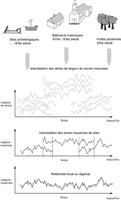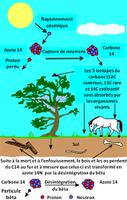
For those researchers working in the field of human history, the chronology of events remains a major element of reflection. Archaeologists have access to various techniques for dating archaeological sites or the objects found on those sites.

Crossdating is an important principle in dendrochronology. It consists in comparing and matching two or more series of ring widths measured on different trees. The partial overlap of sets of trees that died at different times allows the construction of average chronological sequences (courtesy Groupe de recherche en dendrochronologie historique; illustration C. Dagneau)

The Carbon 14 cycle (courtesy Virtual Courseware Project - ScienceCourseware.org).


(courtesy Groupe de recherche en dendrochronologie historique; illustration C. Dagneau)

(Photo courtesy of Thomas Head).

 Balzac Site Stratigraphy French" />
Balzac Site Stratigraphy French" />
(Photo courtesy Thomas Head).


Wall where the Gore Creek skeleton bones were found in 1975, in a gully located near Pritchard, BC. The uppermost white line is Mount St. Helens Y tephra (ash) dated at 3200 years BP, and the lower white line is from the Mount Mazama eruption that took place almost 7000 years ago (courtesy Jerome Cybulski).
For those researchers working in the field of human history, the chronology of events remains a major element of reflection. Archaeologists have access to various techniques for dating archaeological sites or the objects found on those sites. There are two main categories of dating methods in archaeology: indirect or relative dating and absolute dating. Relative dating includes methods that rely on the analysis of comparative data or the context (eg, geological, regional, cultural) in which the object one wishes to date is found. This approach helps to order events chronologically but it does not provide the absolute age of an object expressed in years. Relative dating includes different techniques, but the most commonly used are soil stratigraphy analysis and typology.
On the other hand, absolute dating includes all methods that provide figures about the real estimated age of archaeological objects or occupations. These methods usually analyze physicochemical transformation phenomena whose rate are known or can be estimated relatively well. This is the only type of techniques that can help clarifying the actual age of an object. Absolute dating methods mainly include radiocarbon dating, dendrochronology and thermoluminescence.
Stratigraphy
Inspired by geology, stratigraphy uses the principle of the superposition of strata which suggests that, in a succession of undisturbed SOILS, the upper horizons are newer than the lower ones. Generally, each stratum is isolated in a separate chronological unit that incorporates artifacts. However, this method is sometimes limited because the reoccupation of an area may require excavation to establish the foundation of a building, for instance, that goes through older layers. In this case, even if the foundation of the building is found in the same stratigraphic level as the previous occupation, the two events are not contemporary.
Stratigraphic dating remains very reliable when it comes to dating objects or events in undisturbed stratigraphic levels. For example, the oldest human remains known to date in Canada, found at Gore Creek, have been dated using soil stratification. The bones were buried under (and are therefore older) a layer of ash that resulted from a volcanic eruption dating back to 7000 years BP (Before Present; "present" indicates c. 1950). Subsequently, radiocarbon dating, an absolute dating technique, was used to date the bones directly and provided a date of 8250 BP, showing how useful the combined used of relative and absolute dating can be.
Moreover, stratigraphic dating is sometimes based on the objects that are found within the soil strata. Indeed, some items whose exact or approximate age is known are called "diagnostic artifacts." Examples of such objects include very specific stone tools, different pottery styles, objects that belong to a specific period (eg, the historic period or the French regime), coins with a production date, or other items bearing a trademark and whose history can be traced in historical records. Their presence on archaeological sites is used to date the soil layers and the objects and events they are associated with and thus contributes to refine the chronology of sites.
Typology
Typology is a method that compares reference objects in order to classify them according to their similarity or dissimilarity and link them to a specific context or period. This technique is frequently used when it is impossible to make use of absolute dating methods; it generally allows archaeologists to identify the period to which a cultural site or object belongs, without specifying the date of occupation. This method is primarily applied to projectile points and ceramic vessels. These present many characteristics that are used for comparing them, such as morphology and raw materials in the case of stone tools, and decorative techniques and motifs in the case of ceramics.
Radiocarbon Dating
Radiocarbon dating is the most widely used dating technique in archaeology. It relies on a natural phenomenon that is the foundation of life on earth. Indeed, carbon 14 (14C) is formed from the reaction caused by cosmic rays that convert nitrogen into carbon 14 and then carbon dioxide by combining with carbon 12 (12C) and carbon 13 (13C ), which are stable carbon isotopes. Following the death of an organism, any exchange ceases and the carbon 14, which is radioactive and therefore unstable, slowly begins to disintegrate at a known rate (half-life of 5730 years, ie, after this period only half of the total carbon 14 present at the time of death remains). The amount of carbon 14 remaining in the material to date is compared to a reference standard (ratio 14C/total carbon, 12C and 13C) to calculate the time elapsed since its occurrence. A sample requires 10 to 20 grams of matter and usually consists of charred organic material, mainly charcoal, but bones (see zooarchaeology) and shells can also be dated using this technique. An initial reading dates the specimen which is then calibrated by considering this date and its correspondence with the measurable level of carbon 14 stored over time in the growth rings of certain tree species, including redwood and pine bristol. The results of radiocarbon dating are expressed in years and include a time range (eg, 630± 60 BP). Subsequently, the calibration of that date provides a time interval where the event or object being dated can be situated (eg, 1275-1425 AD). Radiocarbon dating, however, can only be used for dating objects that are less than 50 000 years.
Dendrochronology
Dendrochronology is a method that studies the rings of tree trunks to define characteristic sequences by analyzing the morphology of growth rings for a given species. This method is based on the principle that the variation in tree growth from one year to another is influenced by the degree of precipitation, sunshine, temperature, soil type and all ambient conditions and that, consequently, reference patterns can be distinguished. Several sets of rings from different trees are matched to build an average sequence. Subsequently, overlapping series of average sequences from trees that died at different times and come from various sources (ie, the wood of historic buildings, archaeological and fossil woods) are used to build a chronological sequence covering several hundred years which becomes a reference. Finally, absolute dating is obtained by synchronizing the average sequences with series of live (and thus datable) trees and thus anchors the tree-ring chronology in time.
Dendrochronology mainly uses softwood species that are sensitive to changes in growth conditions, while hardwoods show rather little variation in ring width. This method provides very accurate dating, sometimes to the nearest year. It is especially used to develop calibration curves used to correct data obtained from radiocarbon dating, a technique that remains imprecise due to fluctuations in the concentration of carbon 14 in the atmosphere over the centuries.
Thermoluminescence
Thermoluminescence uses the phenomenon of ionizing radiations that naturally occur in the atmosphere. This technique relies on a unique physicochemical property of certain minerals (especially quartz and feldspar) that have an imperfect structure and therefore retain radioactive elements in the natural environment. When these minerals are heated while a pot is being baked during the occupation of an archaeological site, for instance, the traps formed by their crystal structure are emptied and the clock is reset to zero. Subsequently, the total flow rate of irradiation (paleodose) since the reset is calculated by heating the specimen once more, and this result is then compared to the annual input recorded by a dosimeter installed on the archaeological site where the object being dated was found. The calculation (age of the specimen = paleodose/annual dose) provides information about when the pottery pot was baked and, thereby, about the chronology of the archaeological occupation in which it was found.
Thermoluminescence is a technique that requires complex manipulation. To obtain a date for a single pottery sample, it is necessary to perform a laboratory fractionation of the clay mineral used in the manufacture of the pottery and prepare nearly 75 sub-samples; some of these are heated to release the level of thermoluminescence, while others receive a radiation dose to measure their sensitivity to radiation. Thermoluminescence can replace radiocarbon dating to date events that occurred more than 50 000 years ago; it is used mainly for dating stone fireplaces, ceramics and fire remains.